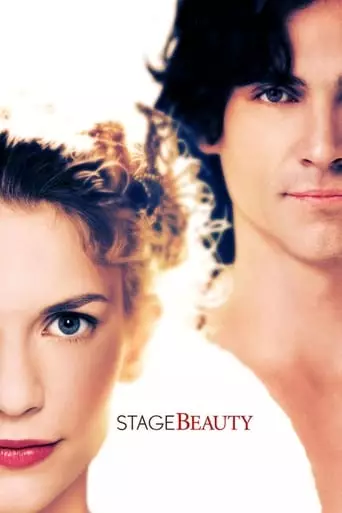Humble Maria, who outfits top London theater star Ned Kynaston, takes none of the credit for the male actor’s success at playing women. And because this is the 17th century, Maria, like other females, is prohibited from pursuing her dream of acting. But when powerful people support her, King Charles II lifts the ban on female stage performers. And just as Maria aided Ned, she needs his help to learn her new profession.
Stage Beauty is a 2004 romantic period drama directed by Richard Eyre, set in 17th-century England during the reign of Charles II. The film centers on Edward Kynaston (Billy Crudup), a renowned actor celebrated for his portrayals of female characters on stage, a practice common before women were permitted to perform in public theaters. Kynaston is at the pinnacle of his career, particularly acclaimed for his role as Desdemona in Othello.
The narrative takes a turn when King Charles II (Rupert Everett) decrees that women are now allowed to perform on stage, leading to the emergence of female actresses. This societal shift threatens Kynaston’s career and identity, as he grapples with the loss of his unique position in the theater world. Maria (Claire Danes), Kynaston’s dresser, seizes the opportunity to pursue her own acting ambitions, adopting the stage name Margaret Hughes. Her rise challenges Kynaston’s dominance and forces him to confront his own insecurities and evolving role in the theatrical community.
The film explores themes of gender roles, identity, and the transformative power of theater. It delves into the complexities of performance, both on and off the stage, highlighting the personal and professional challenges faced by those in the theater industry.
Main Themes
- Gender and Identity
Stage Beauty examines the fluidity of gender roles within the theater, illustrating how societal changes can redefine personal and professional identities. The film portrays the transition from male actors playing female roles to women taking the stage, highlighting the evolving perceptions of gender in performance art.
- Artistic Transformation
The narrative explores the transformative power of theater, showing how characters evolve through their performances. Kynaston’s journey from a celebrated male actor to a mentor for a rising female star underscores the dynamic nature of artistic expression and personal growth.
- Professional Rivalry and Mentorship
The film delves into the complexities of professional relationships, particularly the rivalry and eventual mentorship between Kynaston and Maria. Their interactions reflect themes of competition, collaboration, and the passing of the torch in the theatrical world.
- Societal Change and Resistance
Stage Beauty portrays the societal shifts of the Restoration era, focusing on the resistance to change within the theater community. Kynaston’s reluctance to accept female actresses on stage symbolizes the broader challenges of adapting to new social norms and the fear of obsolescence.
Impact of the Movie
Stage Beauty received positive reviews for its engaging portrayal of the theater world and the complexities of gender roles. Critics praised the film for its strong performances, particularly by Crudup and Danes, and its insightful exploration of the historical context. The film was recognized for its contribution to discussions on gender and performance, offering a nuanced perspective on the evolution of theater and societal norms.
7 Reasons to Watch Stage Beauty (2004)
- Compelling Performances
Billy Crudup and Claire Danes deliver outstanding performances, bringing depth and authenticity to their characters. Crudup’s portrayal of Kynaston captures the complexity of an actor facing professional and personal upheaval, while Danes’ depiction of Maria showcases a woman’s determination to carve her own path in a male-dominated industry.
- Historical Insight
The film offers a window into the Restoration era, providing viewers with a glimpse into the societal norms and theatrical practices of 17th-century England. It highlights the transition from male to female actresses on stage, reflecting broader cultural shifts of the time.
- Exploration of Gender Dynamics
Stage Beauty thoughtfully examines the fluidity of gender roles within the theater, challenging traditional notions and encouraging viewers to reflect on the constructs of masculinity and femininity in performance art.
- Rich Cinematography
The film boasts visually stunning cinematography, with meticulous attention to period details in costumes and set designs. The aesthetic choices immerse viewers in the historical setting, enhancing the storytelling experience.
- Engaging Storyline
The narrative weaves a compelling tale of ambition, rivalry, and personal transformation. It keeps viewers engaged with its blend of drama and romance, set against the backdrop of the evolving theater scene.
- Thought-Provoking Themes
The film delves into themes of identity, societal change, and the transformative power of art. It prompts viewers to consider the impact of external changes on personal identity and the resilience required to adapt to new circumstances.
- Strong Supporting Cast
The ensemble cast, including Rupert Everett and Tom Wilkinson, adds depth to the narrative, with each actor bringing a unique dimension to their roles. Their performances enrich the film’s exploration of the theater world and its characters.
How Will You Feel After Watching Stage Beauty (2004) ?
After watching Stage Beauty, you may feel a sense of admiration for the resilience and adaptability of the characters, particularly Maria’s journey from dresser to actress. The film’s exploration of gender roles and identity may prompt introspection on societal norms and personal transformation. The compelling performances and rich historical context are likely to leave a lasting impression, evoking a deeper appreciation for the art of theater and the complexities of human relationships within it. Overall, the film offers a thought-provoking and emotionally resonant experience that lingers beyond the screen.

